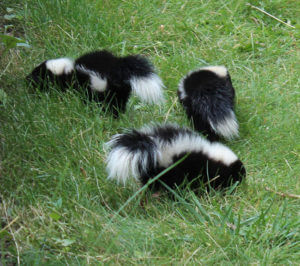
Monthly Archives: March 2014
Skunks

Preventing Skunks
Trapping skunks are one of the easiest ways to control. This prevents further lawn damage while relocating them to a different area. It’s best to cover the trap with a blanket or burlap; skunks tend to avoid spraying if they can’t see their target. However, it’s always best to call a professional when dealing with the trapping and relocation of skunks. This is mainly avoid being sprayed or bitten, as skunks can carry rabies. It’s also important to make sure your home has proper exclusion (fences and sealing under decks).
Skunks don’t have many predators apart from the Great Horned owl. Juveniles are occasionally taken on by foxes, coyotes, and large dogs. Males are slightly larger than females. They are comparable in size to a domestic cat. Females usually reproduce once a year, although males may reproduce with multiple females, and some will travel upwards of 2 to 10 miles to find a female to breed with. Breeding starts in February and March and usually produces a litter between 4 and 7 babies. Males become independent from their mother by July, while the females continue to follow their mother until the following spring. Both males and females become sexually mature around 10 months of age. Most skunks do not survive their first year due to harsh weather conditions or diseases. After their first year they can live up to seven years in the wild and up to ten years in captivity, considering they stay clear of predators, cars and hunters.